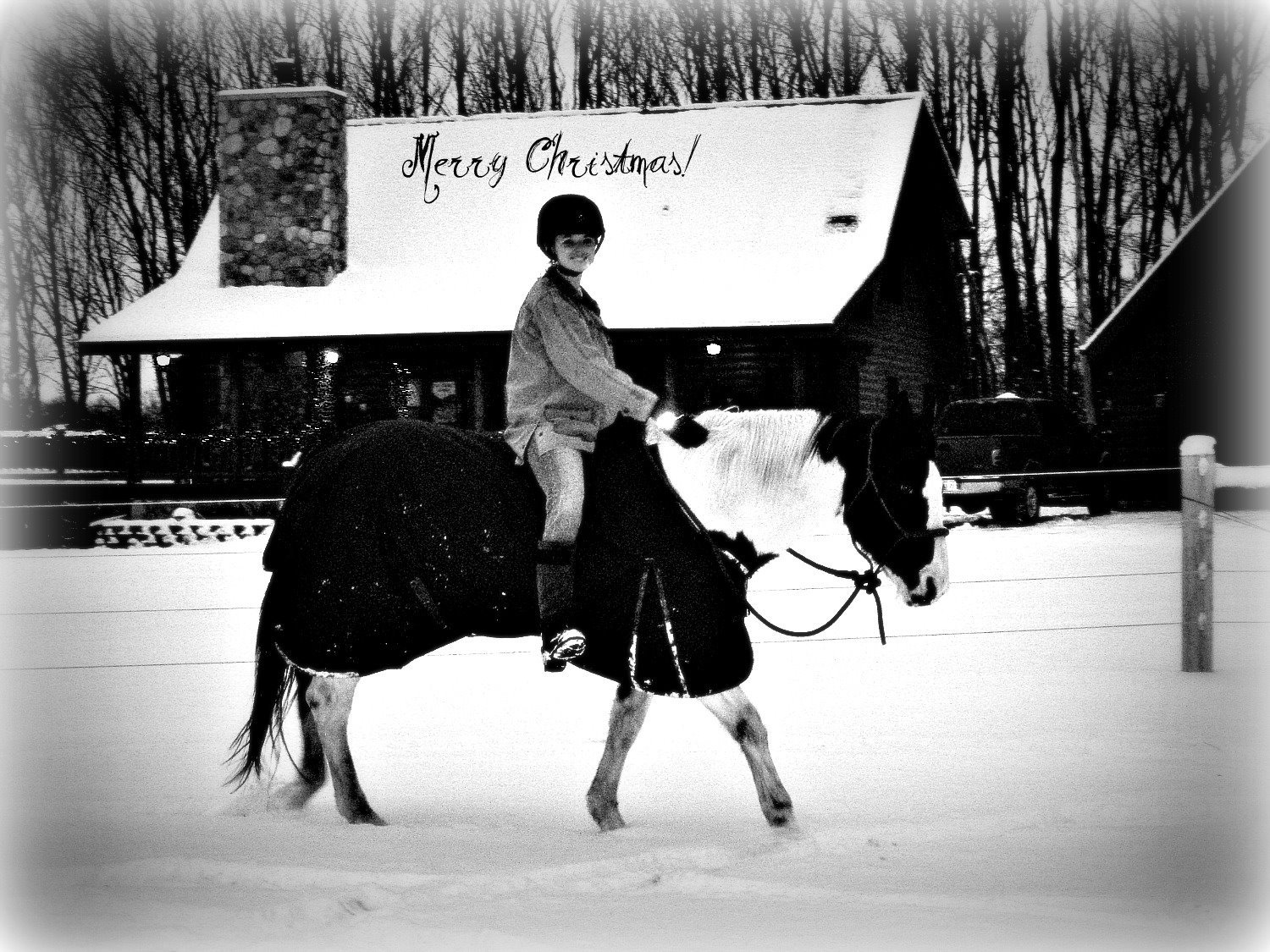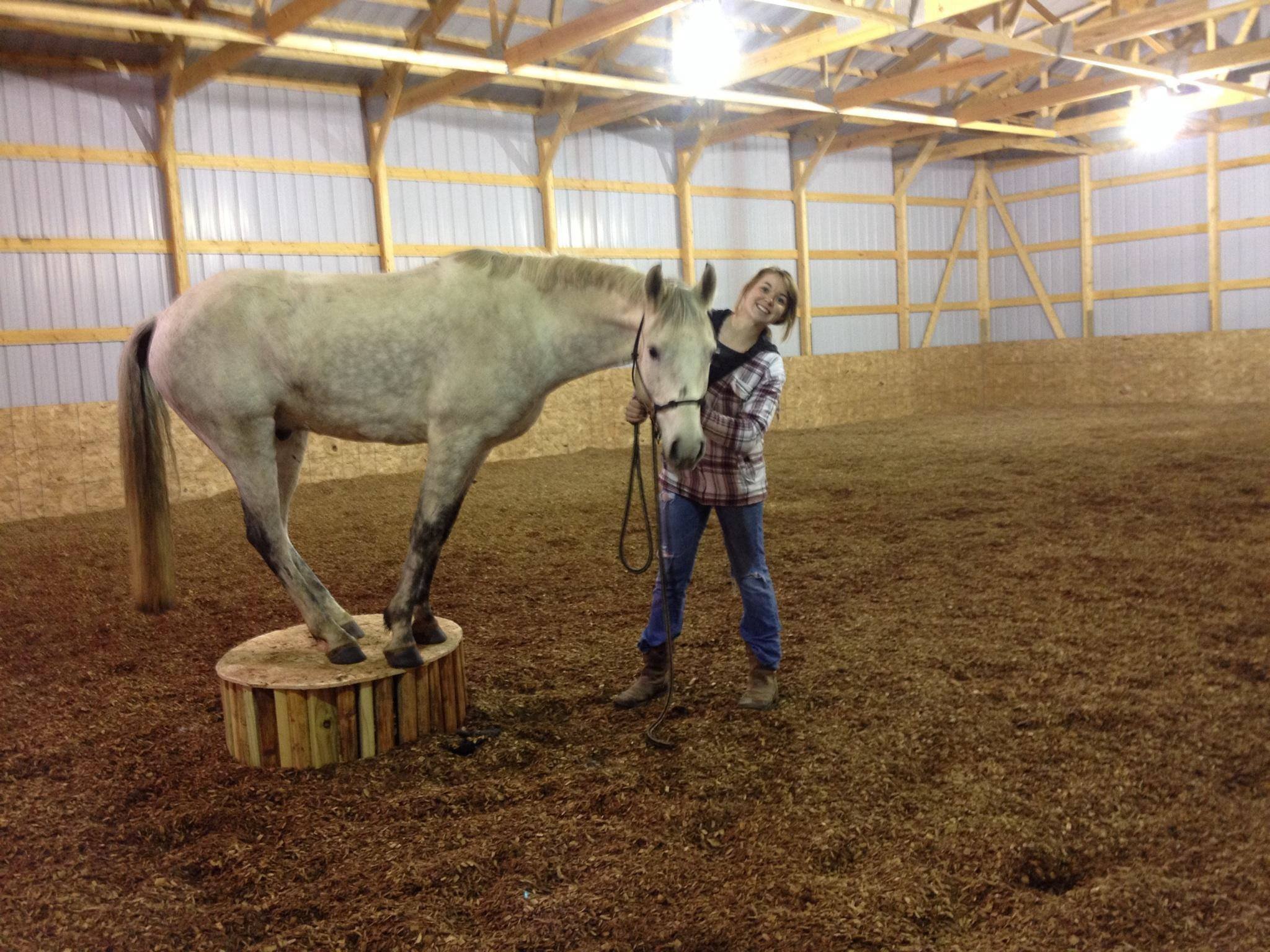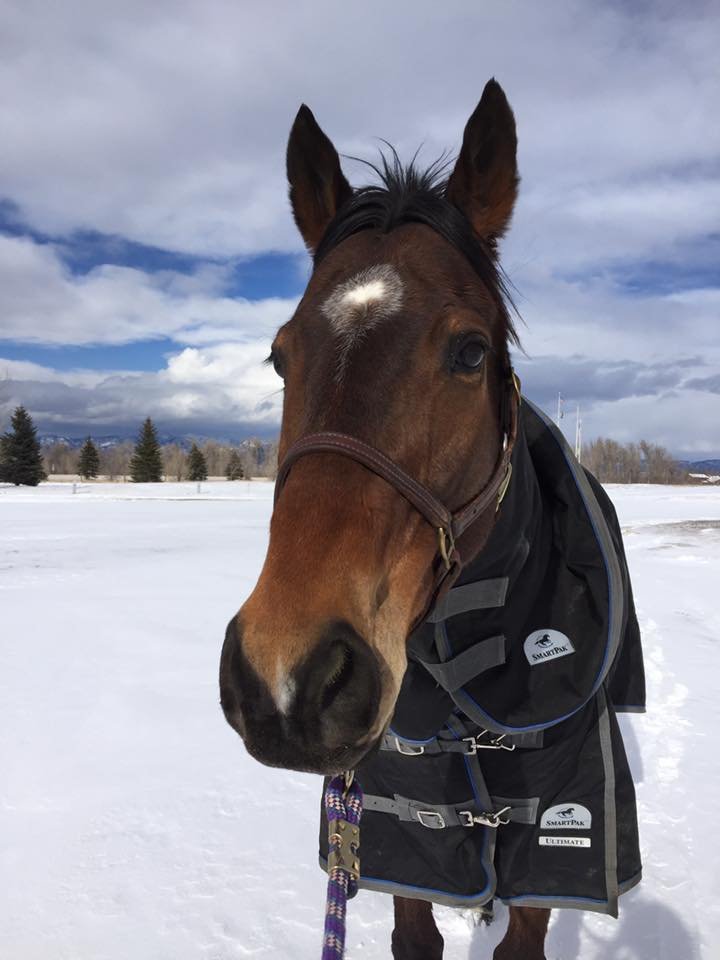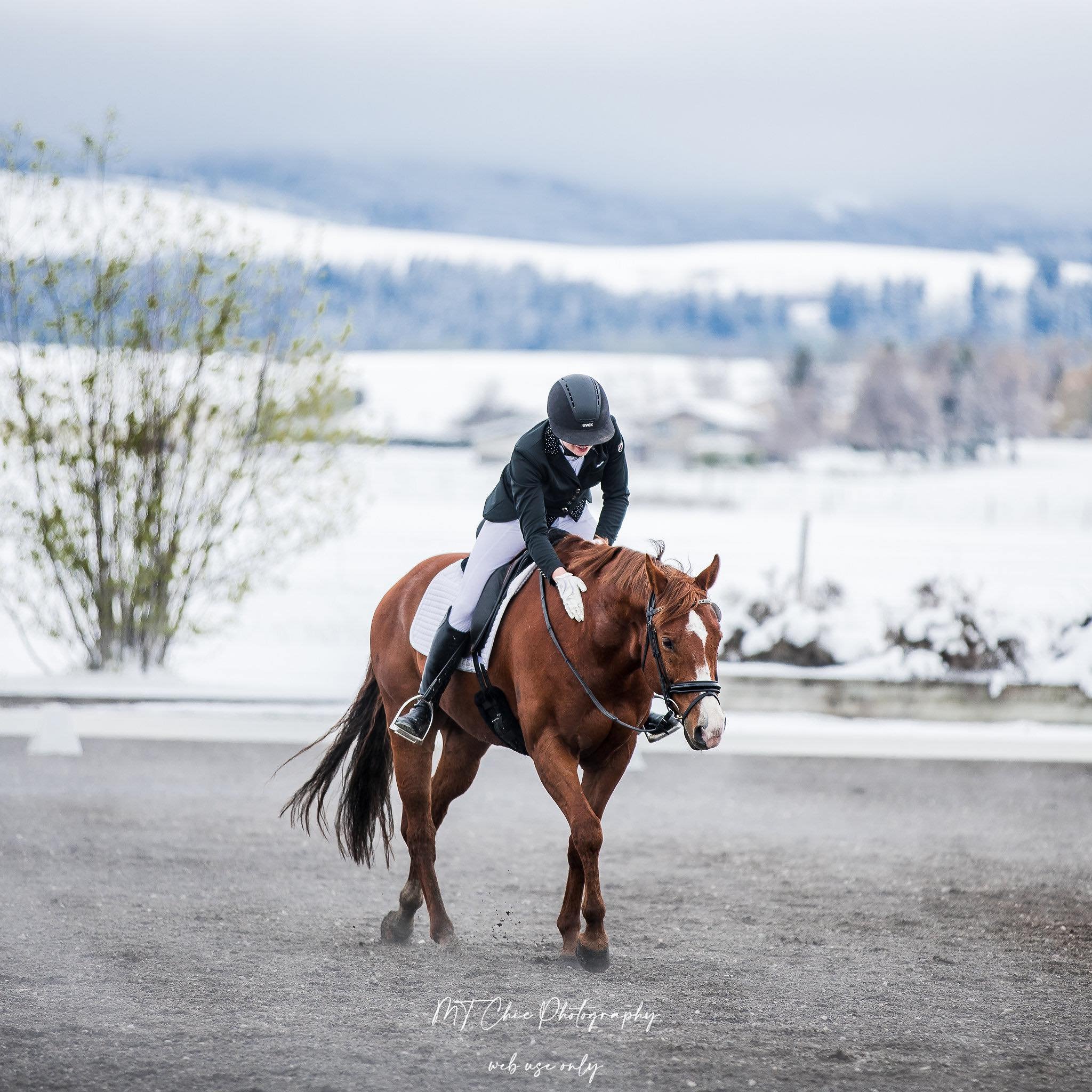Winter Weather Woes
It’s that time of year. Winter has finally arrived!
As someone who has spent their whole life experiencing difficult, snowy, cold, and sometimes downright miserable (hi, Wisconsin!) winters, I find there is always some debate as to “how best” handle winter with horses. And truthfully, as most things, it is very dependent on the situation. Do your horses live outside, or come in? Do you blanket or not? How much hay do you feed or do you change their diet? Do you change their exercise schedule? Do you pull their shoes? With all of these questions, there is plenty of debate, but truly—it is totally dependent on your horse.
Me riding around my APHA mare, Lacey, in the pasture during the winter of 2011.
While I was growing up I was luckily enough to be able to have my horses at home. What a magical, amazing experience. All of our horses lived outside, and we fed grass hay twice a day. None of them got grain, but there was a free-choice vitamin/mineral supplement. For the majority of my childhood, we never blanketed our horses. They were hairy, wooly beasts and were perfectly content with their conditions. We never had any colic episodes or injuries. They all lived together in a group. During blizzards, which would last days at a time, we would bring them inside and utilize our little four stall barn, Truthfully, I think they would’ve much preferred just being left outside, but it was more to ease our ability to care for them. I remember days where you couldn’t see the barn from our house, even though it was just a few hundred feet away. They all got the winter off, besides some fun bareback rides through the snow. We always kept our horses barefoot, very rarely putting just front shoes on for the summer.
As I grew older, and more serious about riding, I learned how to clip my horses and blanket them. My first clip jobs were atrocious, but they served their purpose. My mom scraped together some savings, negotiated with a builder and had a small indoor (60x100) built on the property. It was uninsulated, dusty, and hardly big enough to ride more than a circle, but was just enough for me to ride year-round. It was perfect and wonderful and most specially: ours. My pony received adequate hay to stay warm and happy, but still lived outside.
Finn circa 2014, learning how to stand on the pedestal. My mom hand-made this pedestal and I taught all of my horses how to stand on it, even while riding!
As I matured in my knowledge and competitive spirit, I saw that most people that were serious about riding year-round blanketed their horses. Horses that were in work (and not) needed adequate nutrition: protein, vitamins, minerals, fats—etc and were therefore fed a concentrate. Ration balancers were just beginning to get popular for those “easy keepers”. It made it easier to ride if you clipped your horse so they would dry faster. A lot of competition horses came into stalls at night for a multitude of reasons (separating for feeding purposes, removing the need to blanket heavily at night, being able to “keep eyes” on them easier, paddocks that didn’t have shelters, etc). It was a different world than my “backyard” horse experience. And quite a bit more expensive.
Finn showing at North Run Farms in Delano, MN—a “short” two-hour drive for a wonderful schooling show series in a heated, insulated barn. And yes, I roached his mane thinking it was fashionable (eek). Circa 2014.
That was really at the head of it, I think. Looking back, as I progressed forwards in sport and left my “backyard horse owner” background, things got to be quite a bit more expensive. If I wanted to progress during the winter and attend little schooling shows, my $300 pony needed to get clipped (cue $150 for clippers and blades), stay blanketed ($200-$400 for a basic set of blankets), and receive supplemental concentrates ($50-$60/month in feed). Luckily, he always stayed barefoot, so that saved about $50/month (yes, I remember when front shoes were just right around $100). It was part of the progression of care I needed to maintain to reflect my goals. The few times that we did board him (to be able to take lessons or have additional training we couldn’t get at home) he stayed in a stall at night. I remember when pasture board was $200, and stall board was anywhere from $400-$600, and lessons were $40. My, how times have changed.
Moving out to Montana, I adopted a less “one size fits all” approach. Some of my training horses in the winter are traced clipped if necessary, and blanketed appropriately. I clip them if they are going to break a sweat while working. Some of my training horses are blanketed but not clipped (to keep their hair coat short and clean). Some of my horses are unblanketed, which does affect our training schedule if it is actively snowing and they are covered with an insulating layer over their back (makes it to where they need more time to dry off adequately before being tacked up, or going back outside). I find a good happy-medium is to blanket accordingly to keep the hair coat short and clean, and to minimize drying time if they are going to stay in work. Though, remember, if you are going to blanket, you remove the horses ability to “self-insulate”. No matter how hairy they are, you must blanket appropriately for the temperature with the appropriate # of grams of fill.'
Layover in Seattle, aka “Jet”, perfectly comfortable and happy in his SmartPak Ultimate blanket set, circa 2016. Blanketing in Montana is tricky, and takes a good feel for the weather and how best to keep the horses comfortable.
Currently, some of my training horses come into stalls at night. The horses that do so are my FEI horses and a valuable youngster that will also be traveling to shows with them. The majority of my training horses live outside. Could my FEI horses live outside? Yes—but again, there is a multitude of factors that fit into that decision to keep them in at night. It’s never truly a “one size fits all”. My personal preference is for horses to be out in a small group that gets along, with 24/7 forage if possible (not for those with IR or weight issues). Unfortunately, that isn’t feasible on every property or for every situation.
Do I pull shoes? Occasionally, I will have a horse I will pull shoes on for the winter. These are typically the ones that have gone barefoot the majority of their life, and just go in shoes for the “wear and tear” of the summer riding on hard, sometimes rocky, ground. What I’ve found in my experience to be the most important is the timing. Ideally, we pull shoes when the ground is soft. Trying to time it to not pull them when its in the cycle of muddy/frozen, icy, etc—takes quite a bit of feel for the weather, your horse and what they can handle, and your gut. If you do pull shoes earlier in the winter, it is always a good idea to have a pair of barefoot boots around if your horse gets a little sore. Catching it early and putting on the boots can save a world of headache, time, and money.
If you find that your horse is losing weight or condition in the winter, and you blanket appropriately, feed a concentrate, and have kept them in the same amount of work from the summer, don’t hesitate to reach out to a nutritionist and gauge their perspective. It could very easily be that your horse needs additional calories from forage or a concentrate (most people underfeed their concentrates—not feeding them at the weight they are meant to be fed). Also evaluate whether or not they are in the appropriate blanket during winter weather (grams of insulation appropriate for the temperature) and if they have an adequate windbreak. For those that are a bit trickier “hard keepers”, I tend to keep a more observant eye on their blanketing and if they feel “cold” under their blankets. If it is stormy, windy, or cloudy (or all of the above) I tend to blanket those horses a tiny bit heavier than their counterparts, keeping a keen eye on the temperature and cloud cover to make sure they don’t overheat. Another great program to use to see if you are feeding adequately for your horse is FeedXL. Plug in their weight, exercise load, and hay analysis if you have it, and off you go.
Henry showing in the snow at a schooling show, “spring” of 2021.
Exercise is tricky. Years ago, a study came out that exercising horses in temperatures below 4* (celcius) was damaging to their airways, similar to an asthmatic condition in humans called “skiers asthma”. This happens due to acute airway obstruction when cold air gets down into the lungs and damages tissues. Oklahoma State University found that horses exercising on a treadmill while breathing in chilled air experienced mucosal injuries to their airways—contributing to the development of asthma. When do you cut off exercising your horses?
For me personally, I’ve found it tolerable to ride in temperatures to around 20* (Fahrenheit) regularly—walking, trotting, and cantering. I have not personally experienced a detriment to my horses breathing while riding in these temperatures. Anything below 20, I tend to back off, only working at the walk or trot or lightly cantering a lap or two. Below 10* I bring the horses inside, groom them and handwalk them, and give them “tea”, which is a mix of lukewarm water, a handful of super palatable feed, and some sea salt. These are the times in the winter where it is good to slow down, become introspective about your horses training, and work on groundwork or proprioception-type exercises (backing up, walking over raised poles, etc). A natural break built into the riding schedule.
As miserable as winter can be for those of us that work outisde, it can also be incredibly peaceful. It is a time for introspection, solitude, and rest (in whatever capacity we can provide it) for our bodies.
If you feel like you are lost, your horse is full of it, your rides aren’t productive or the weather is simply stymying you from progression, don’t be afraid to lean into it. And by that, I mean take a moment to give yourself grace for not being a super-human. Humans are meant to rest and digest in the winter. It’s hard to maintain that drive that one feels in the summer. Don’t be afraid to take this time to do groundwork with your horse, groom them, and just generally spend time with them. If you can, keeping them exercised (depending on the horse) is great. If you can’t, accepting that you might need to pivot because of the weather is just half the battle. Keep in mind you are on the path you are meant to be on, and that in itself is “okay”. You will live to fight another day! And spring is right around the corner.
A beautiful view from ‘C’ at the Bridger Canyon Stallion Station.







